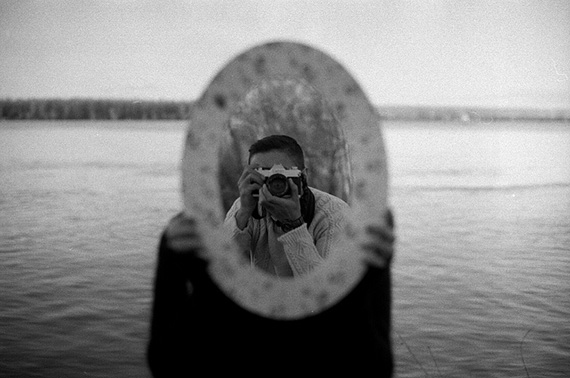Change is continuous, and language evolves as a consequence. Fresh words are formulated or old words are re-purposed to name new things. In the field of photography, the new word is analogue, and it’s applied to something old.

photo by Kevin Dooley
This term has crept into common usage as a means of differentiating between film and digital photography, and thus analogue photography has come to mean anything that is “not digital.” But, it’s an ill-conceived name, and not entirely fit for its purpose.
So what does analogue actually mean?
The adjective “analogous” is from the Greek word analogos, meaning “comparable in certain respects.” From this comes the noun “analogue,” which is used to name a thing that is similar to another thing (e.g., The ethos of “return love for hatred” is a Taoist analogue to Christianity’s “love thy enemy.”)
This name applied to film photography therefore seems paradoxical, since it serves to highlight the differences between film and digital photography via use of a term that is more correctly used to recognize similarities.

photo by Alexandru Paraschiv
Analogue has a further specialized meaning. It refers to a signal where the output is proportional to the input, normally in relation to the combination of a device and a media that can together measure, record, or reproduce continuous information.
For example, older telephones converted the vibration of sounds to electric current, which traveled a wire, and upon reaching its destination was converted back into amplified vibrations. A tape recorder converted sound information to magnetism on the surface of the tape, and these fields were later converted into electrical current by the reading head, which was in turn amplified and transformed into vibration of a speaker.
On this basis, the sensor in a digital camera is also an analogue system. Each of the many millions of pixels in the sensor is a light-sensitive photocell, which generates a tiny electrical current in response to light: the brighter the light, the stronger the current. It only becomes a digital system when the brightness levels are coded into the binary (digital) record of that image.
The word “digital” comes from digit, as in fingers and toes. We count on our fingers (sometimes our toes), and so digit has also come to mean numbers. Digital systems use numbers to store and manipulate information. But I digress…
Film photography is not a true analogue process: it’s a chemical process whereby exposing light sensitive photographic film requires chemical solutions to develop and stabilize the image.

photo by Jeff Ruane
So, there’s another irony to our new terminology. Digital photography is underpinned by an analogue system, and film photography is not a true analogue process. Only the first non-film cameras were wholly analogue systems: they recorded pixel signals continuously, as videotape machines did.
To add further confusion, there are two different spellings of the word. “Analogue” is the traditional English spelling, while the phonetically simplified “analog” is American. However, in the USA both words are used. Analog generally refers to electronics devices, while analogue is often reserved for use in the sense something that bears a resemblance to something else (or so I understand).
Both Fuji Film and Canon’s websites use the word “analogue” to identify film photography. It’s nice that they have adopted the English spelling, but this description also imitates that the disagreeable term has become fully embedded in today’s language.
To avoid the potential confusion between film and digital, and avoid the inappropriateness of analogue, the French have adopted the word argentic to describe non-digital photography. Argentic means silver and is a suitable name because it acknowledges the silver halide crystals that make up the film emulsion.

photo by Ed T
The choice exists: we can go with the flow and use a term that differentiates film photography by saying it’s similar to digital, and further miss-describes the chemical process of film development, or we could adopt the French term argentic, which clearly describes film photography. That would be nice!
About the Author:
This article was written by John A Burton, you can see his Film Camera Collection on his website.
Like This Article?
Don't Miss The Next One!
Join over 100,000 photographers of all experience levels who receive our free photography tips and articles to stay current:






I completely disagree with this article. Analog photography is indeed analog. There is nothing digital about it. I am not a hipster, and I also hate when the word “analog” is used incorrectly, by hipsters or anyone.
Digital cameras are digital because of the way the bits are read from the sensor and converted to numbers. It doesn’t matter if the cells in a sensor are analog in the way they accumulate light, the image is quantized/digitized after that point, and stored in a “computer file”. How can you say that isn’t digital?
Is digital audio not digital, just because the original audio was analog prior to getting quantized by an A/D converter? Of course not! The same holds true for a digital camera. The light waves coming in are analog, the picture coming out is digital.
re: Michael Baxter: [Analog cameras are] digital because the shutter action is most definitely a digital sampling function.
No it is not. The longer the shutter is held open, the more white/washed-out the picture will be… that is analog! Nothing is being converted into numbers. The fact that the shutter is “sampling” the light, and the film grain acts like “pixels” on a tiny scale, does not make it digital.
> Video recording into magnetic tape however is not analog either, it’s digital. Because it has a frame-rate
Ridiculous! Analog video (NTSC/PAL) also has a framerate and scanlines. It is analog because the video signal is a continuously varying voltage. It is recorded onto tape in that same way. Breaking it into lines and frames and color bursts does not change that.
So, what are we going to do, to educate people in the correct terminology???
The words “analog photography” hurt my eyes too, but perhaps for different reasons. It defintely should just be called “film phroography.”
IMHO, so-called analog/analogue photography actually really *is* digital.
It’s not analog/analogue, because it’s some supposed opposite; e.g. not done with digital imagers and digital signal processing.
It’s digital because the shutter action is most definitely a digital sampling function.
Audio magnetic tape recording *is* analog, because continuous time analog signals are impinged upon the magnetic coating continously in hard realtime, and recovered the same way. Audio magnetic tape has no aperture.
Video recording into magnetic tape however is not analog either, it’s digital. Because it has a frame-rate, which is a vertical aperture. In addition, the scanlines recorded are discrete as well, a horizontal aperture.
Any n-dimensional signal processing element with an aperture has a digital nature fundamentally, and can alias. Motion blur in film is a form of alias, a susceptability that depends solely on Tv, which relates to the discete operation of the shutter.
Thank you. This answered my question.
Thank You Thank You Thank You .. I’ve been railing aginst this for over a decade…I feel like the Man from La Mancha “leaning against Windmills”. I too, have said so called digital photography is analgous to traditional film photography, nobody’s listening. The anachronistic embrace of the major film producers of the term certainly doesn’t help. I suppose the dollars make sense. I also loudly applaud the poster Peter Jones suggesting to edit the Wiki page on this. ..
Sorely Tempted
Hi, Excellent explanation on how silver halide photography is not analogue. I wonder if you might consider editing the dreadfully inaccurate Wikipedia page on ‘Analog Photography’
https://en.wikipedia.org/wiki/Analog_photography
Best regards,
Peter Jones
Finally found an article about this!!!!!!!!!
The title of your article is exactly what I say to students at the university where I work (south of Brazil).
I’ve been working with film and laboratory for 25 years and it really hurts my ears to hear people calling film analog. Especially because I also studied analog systems in adolescence. And because I continue studying photochemistry until today!
Why have not they called film “analog” before the popularization of digital equipments/systems ?! Digital, as you said, are closer to an analog system than the film (photochemical). The problem is the speed that information is spreading today, and the use of certain wrong expressions and concepts without studying more deeply about it, or even wondering if this or that is correct, simply because the majority has come to call like this.
Congratulations and tank you for the article!!!!!!!!
Good article. I really don’t like words repurposed by hipsters just to give the (false) impression they know what they are talking about.